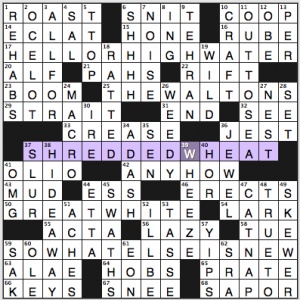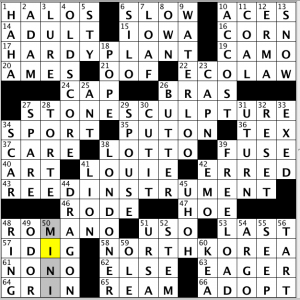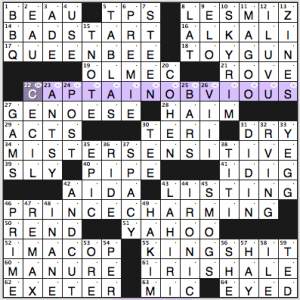NYT 3:04
Blindauer untimed (Matt)
Tausig untimed (Amy)
LAT 4:14 (Gareth)
CS 5:11 (Dave)
Tracy Gray’s New York Times crossword
I like the theme all right, but yet again we have an NYT puzzle racked with iffy fill. I hate to sound like a broken record, but as long as fill like SHHHH and HOBS and OBE and SNEE continue to populate the grids, I’m going to complain.
- 17a. [*Any foreseeable difficulty], HELL OR HIGH WATER. Basically a long partial, as “come hell or high water” is the unit of meaning here.
- 25a. [*”Good night, John-Boy” series], THE WALTONS.
- 37a. [Breakfast cereal … or a hint to what’s found in the answers to the four starred clues?], SHREDDED WHEAT. WHEAT is scrambled, or SHREDDED, with the letters in a different order in each of the themers.
- 50a. [*Fearsome shark], GREAT WHITE.
- 59a. [*”Why am I not surprised?”], “SO, WHAT ELSE IS NEW?”
Does the fill mean that 63 theme squares was too much for the constructor to wrangle into shape? Does the grid pattern force compromises? At least this wasn’t a case of forcing a pangram and accepting whatever junk that too often entails. Now, if the NYT daily puzzles took titles, the title could have been “Shredded Wheat” and the four themers could have spread themselves apart a bit more, letting the grid breathe.
What did I have issues with? A lotta stuff, actually:
- The crossing of 16a. [Con artist’s mark], RUBE, and 12d. [Knighthood letters], OBE. Why, oh why, wasn’t that B an N or a D? I don’t see RUNE/ONE or RUDE/ODE elsewhere in the grid. Constructors! If you have an entry like OBE in your grid, please be sure that there’s no way around using it.
- 21a. [Oom-___ (tuba sounds)], PAHS. Some dictionaries don’t hyphenate that, and while PAH is a stand-alone word in its own (sad) right, it’s an interjection and not a pluralizable noun. I’m thinking the theme answers needed to be laid out differently to clean up this section, because 6d. [“Quiet, please!”], SHHHH, has far too many H’s, but the theme answers being slotted where they are mandates that 6d be **H*H. What else is going to fit that pattern?
- Crosswordese on parade: ACTA, ALAE, and SNEE all in the same neighborhood at the bottom. A highly regarded constructor was recently telling me that he strives to never, ever include SNEE in his puzzles and if he did get backed into using it in a tough grid, he’d clue it as NFL player Chris Snee, who gets more play in today’s media than 67a. [Knife of old] does. (OLIO and ESS also put in an appearance, as does 40d. [Vert.’s opposite], HOR. And the French word TASSE, 53d. [Café au lait holder].)
- 64a. [Gear-cutting tools], HOBS. I never cut any gears, so this is not a word I use. Is Wednesday late enough in the week for more arcane vocabulary?
- 59d. [Cinch ___ (trash bag brand)], SAK. SAKS would be a great answer, as in Saks Fifth Avenue, but SAK is not pretty.
2.75 stars from me. I want more polished fill! Is that so much to ask? If constructors submit grids like these, send the puzzles back for rework or doctor the fill yourself.
Gail Grabowski’s CrosSynergy / Washington Post crossword, “Oliver Branch” – Dave Sullivan’s review
I first thought we’d have an “add-an-R” theme (Olive -> Oliver in title), but instead, we have four theme entries where the first word is the last name of a famous Oliver.
- [Weather-resistant botanical buy] was HARDY PLANT – Oliver Hardy of Laurel & Hardy fame, not to be confused with his brother Thomas, author of Far from the Madding Crowd. I’m wondering if “hardy plant” is a bit “green paint”-ish, just being an adjective + noun as opposed to a lexical chunk. Vote for or against its chunkiness in the comments.
- [Mount Rushmore, e.g.] was STONE SCULPTURE – Oliver Stone, movie director. Again, I’m not entirely convinced of the phrase-worthiness of this, as most stone sculptures I have seen are just referred to as sculptures.
- [Alto saxophone, e.g.] clued REED INSTRUMENT – Actor Oliver Reed, whose credits include, appropriately enough, Oliver!.
- [Pyongyang’s locale] was NORTH KOREA – of all the norths out there, we choose this country? Oliver North is probably best known for his role in the Iran-Contra Affair.
I kept waiting for the TWIST AND SHOUT shoe to drop, but perhaps it’s still lying (no object!) on the editor’s cutting room floor. Sort of also curious about why AMES and IOWA weren’t clued together, since the former was clued (on its own) as [Midwestern college town]. OLD SCORE for [Something you may want to settle] was nice as was Napoleon’s WATERLOO, also a famous train station where LONDONERs hang out. I’m a bit baffled by MINI for [Course opening?]. Is there such a thing as a mini-course or am I (quite likely) misinterpreting the clue?
Patrick Blindauer’s website puzzle, “Target Practice”—Matt’s review

Amusing visual theme from Patrick this month: echoing Cupid’s February arrows, we have an archery target comprised of the grid’s 53 (!) O’s.
To make this work he had to use OOO six times and OOOOO twice, which is illegal — but what are YOU gonna do about, huh? He’s Patrick Blindauer and this is his personal website, so he can do as he likes. He did have the goooood sense to clooooo it differently each time, of course. OOO is [Queenside castling notation] and [The Land of ___ (“Adventure Time” setting)] and [“___ Baby Baby” (1965 hit)] and [Winning line] and [Snowman or stoplight, symbolically] and [Love letters?]. Not sure if this last one refers to love as in zero in tennis, or if “Ooo” is a lover’s coo, but the chess one was my favorite anyway.
OOOOO is clued as [“Super Mastermind” row, symbolically] and [Witch house pioneer, along with Salem and White Ring]. Was this the sequel to “Adventure Time”? That’s my way of conveying that I’m not familiar with either of those references. But I am familiar with Super Mastermind, which I was once quite skilled at.
Turns out that oOoOO is a San Francisco-based artist “often recognized as a pioneer of the Witch house sound” according to Wikipedia (which tells us that his name is “pronounced as “oh”). That’s good, so if I ever meet him I won’t accidentally pronounce it as “oOoOO.”
I jest, but he’s pretty good: http://www.youtube.com/watch?v=GXx5Qk1iP1M
Other O-rich content: OH NO, OSSO, OOZED, ACHOO, MAGOO and OOMPA.
Coooool. I’d like to give this 4.OO stars (those ain’t zeroes) but it deserves more. So we’ll make it 4.2O.
C. C. Burnikel’s Los Angeles Times crossword

LAT
140205
C. C. (aka Zhouqin) Burnikel gives us a simple, but playful theme. 90210 is spelt out at the beginnings of five entries and revealed with the entries BEVERLY/HILLS crossing in the bottom-right. This unusual arrangement forces pairs of across answers on top of each other rather than the more usual alternating sides. The entries themselves were peppy enough too, especially the first:
- 18a, [Polite refusal, in Nuremberg], NEINDANKE.
- 24a, [“Fall on your knees” carol], OHOLYNIGHT
- 35a, [Somewhat], TOADAGREE. Also useful for any potential hide an amphibian theme!
- 51a, [Only just broke the tape], WONBYANOSE
- 58a, [“You gotta be kidding!”], OHBROTHER
There seemed to be quite a lot going on among the longer answers. My personal favourites include DIANTHUS (though the less biologically-inclined may disagree), OSPREY, DRYHEAT, TARPITS and MAKEHAY (which has become detached from its original idiom of late.
Seeing [Quite a while] for both MONTH and EONS says something about how its meaning is mostly determined by context.
4 stars
Gareth
Ben Tausig’s Ink Well/Chicago Reader crossword, “Unofficial Titles”
Five theme answers are slangy titles for people:
- 17a. [Title for a social leader], QUEEN BEE. Like an alpha dog, but more regal.
- 22a. [Title for one who says what’s already clear], CAPTAIN OBVIOUS.
- 34a. [Title for a touchy person], MISTER SENSITIVE.
- 46a. [Title for a Romeo], PRINCE CHARMING.
- 55a. [Title for a haughty type], KING SHIT. This one was new to me.
Fresh and lively theme answers, no? We’ve got 59 theme squares, which is a bit on the heavy side. Let us examine the grid for good fill and terrible fill.
Likes: LES MIZ, BAD START, TOY GUN, IRISH ALE, BBQ (which I much prefer to BARBQ), “…AND CUT!,” the [Critically acclaimed role-playing game in the “Elder Scrolls” series] SKYRIM, author Jhumpa LAHIRI. A solid number of zippy entries.
Could do without: “I DIG” (are people saying that much?), TITI ([South American monkey]), I LUV U, ILE, YEGG. HAKIM is tough to clue; I didn’t know it was an [Arabic honorific] but did know it as the last name of some Minnesotans I went to college with. Five answers in my “meh” list is survivable. It’s when the list sprawls to 10+ that this solver grows ever more scowly. I hereby declare that Ben T. has solid grid-filling chops.
3.75 stars from me.



Hey, you stole my “should’ve been sent back” line, as well as my “that –H-H pattern is death” line. Wait, I haven’t posted yet. Never mind.
I don’t know about you, Michael, but I often hear things along the lines of “Rex is so negative”/”Rex just hates everything”/”Amy is far more judicious than Rex in her criticisms.” It’s funny because our critiques so often touch on the same points! The things you deplore, I express consternation at. It’s a gradation of tone, but we’re working to prove the same thesis.
Actually, I kinda like the wackiness of SHHHH in the grid. It’s the kind of entry that you used to see in the old classic Games Magazine puzzles (ed. by W. Shortz) of yore. Both Hook and Reagle were especially fond of such stuff… and if not overdone, an unusual entry like this would add zing to the grid, and mark it out as something the (then) stuffy old NYT would never ever have allowed.
BTW, I can also see the other side of the argument as in: four H’s is OK then how about five, six or more, where does it end? But now we’re thinking sensibly … and missing the fun side of the entry, which, I admit did give me a smile,
-Martin
Yeah SHHHH is defensible and endearingly wacky, but I think four H’s is the maximum carrying load.
“Both Hook and Reagle were especially fond of such stuff… ”
And, as far as I know, still are.
And another thing while I’m at it ;)
Let me play the proverbial devil’s advocate and argue a case for OBE in the top RH corner:
Imagine this top RH corner is really part of a tough Saturday puzzle. Also imagine that (of course) the clues are especially tough in that area, so much so that RU?E and O?E are stumpers. If the editor/constructor always selected the best crossings, then required B would not probably not be guessed by experienced solvers, because they would assume that the best fill should be the correct answer always.
So am I making a case for poor fill. Well, yes, maybe … but only in some circumstances.
-Martin
Respectfully disagree. If you want to make a puzzle challenging, write challenging clues for clean entries. I will never make a case for including bad entries when a one-letter fix is all it takes to eliminate it.
Andrew… as I said, I’m playing the devil’s advocate here. Personally, I agree with you.
-Martin
re NYT 21a:
Eugene Maleska is a much disliked, regrettably even vilified figure, in the history of the crossword puzzle. But I have a warm spot for him. During his tenure as Editor, he instituted the “Gotcha” award — a diploma printed in academic style — which he would send to anyone who pointed out an error, which he accepted as such, in a NYT puzzle. He insisted that he awarded them *very* rarely, though I don’t have any statistics. There was something endearingly whimsical about the idea, and more to the point (obviously) — I received one, and still guard it with pride.
The entry for which I received the award was
{Tuba sound} cluing ‘OOMPAHPAH.’
In my letter to him, I pointed out that the tubas only go OOM, and that the *other* band instruments respond “PAH PAH.”
As I say, he sustained my assignment of error, and a couple weeks later I received my plaque, along with a very nice, personalized letter.
I agree with many of the criticisms of today’s puzzle, but this is another instance where I seem to value a creative, interesting, well-executed theme relatively more highly than others.
Bruce, I agree with your overall reaction, even though I don’t have a Gotcha to my name. Some days, the puzzle actively annoys me, this one made me smile. Maybe it was the SHREDDED WHEAT that set an all American tone to the rest of the theme…
ANYHOW, WHEEZE, CATNAP, HIDEAWAY, SAPOR, all SKEWED towards the good.
I started doing the NYT crossword during the Maleska era, as a teenager. I initially found them nearly impossible to solve, but after lots of practice, I considered it a badge of honor to be able to solve the NYT crossword puzzle.
Now people complain if not everybody can solve the NYT crossword. Too hard, too obscure, unfair. Not that I think we need to go backwards in time. The Maleska era could be snobbish about what wasn’t crossword worthy. But people still have that snobbery, about different things now, and strangely there seems to be an anti-intellectual bent among many people regarding the puzzle.
Amen.
If the NYT crossword wants to be intellectual, then it’s doing a pretty poor job of it. Given the thousands and thousands of intellectually-minded fill possible, if you have to resort to rather lame fill like PAHS and HOBS, that’d be pretty pathetic.
Rather, I don’t think the goal of the NYT is to service the intellectual. Instead, I don’t think the NYT really knows what the heck it wants.
You meant “lying,” not “laying,” right? Unless that was what the twisting and shouting were about.
Thanks, LCZ…I’ve corrected the post.
Thanks! It would have bothered me all day ((*_*))
Apart from anything else, OBE is incorrectly clued. In full, it means “Officer of the Most Excellent Order of the British Empire,” which is distinct from a knighthood, and doesn’t entitle you to be called “sir.” I had an uncle who got an OBE, and he didn’t become known as Sir [uncle’s name].
Wikipedia tells you more than you want to know.
SHHHH is mental. OBE on the other hand is in the media in a big way whenever anybody is up for one; I don’t understand the objection.
It’s not in the media nearly as much in the States, which accounts for the complaints from over here.
But my wife is English and we lived overseas, so for me OBE is a gimme…if not quite correctly clued, as David L. points out. More like the first step to knighthood than knighthood itself, if you want to get technical.
OBE, CBE, MBE are terms you hear all the time in England. Just heard them yesterday while watching Top Gear.
“[Love letters?]. Not sure if this last one refers to love as in zero in tennis, or if “Ooo” is a lover’s coo,…”
More likely hugs, as in “xoxoxoxox”.